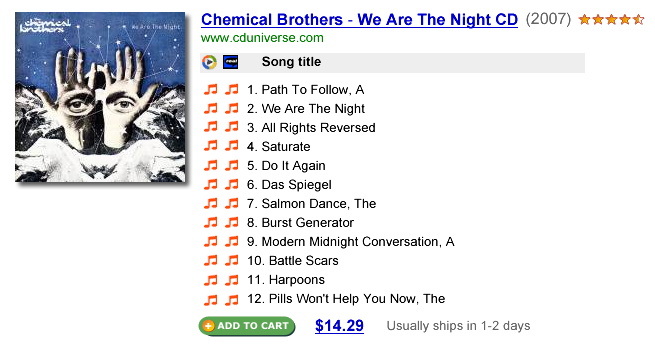이 페이지에서는 웹사이트의 결과 스니펫을 맞춤설정하는 방법을 설명합니다. 맞춤 스니펫을 렌더링하려면 웹페이지에 구조화된 데이터를 추가해야 합니다.
개요
프로그래밍 검색 엔진은 스니펫을 표시하여 사용자가 올바른 페이지를 찾을 수 있도록 도와줍니다. 스니펫은 검색 사용자가 웹페이지에 있는 내용을 파악할 수 있는 작은 콘텐츠 샘플입니다. 스니펫에 관해 자세히 알아보려면 검색결과 분석에 관한 웹마스터 센터 블로그 게시물을 참고하세요. 프로그래밍 검색 엔진 알고리즘에서 만든 표준 스니펫이 마음에 들지 않으면 직접 스니펫을 만들 수 있습니다. 이미지 썸네일, 요약, 날짜, 작성자, 평점, 가격 등의 주요 정보를 스니펫에 바로 표시할 수 있습니다. 검색결과에 관련성이 가장 높은 정보가 포함되면 사이트의 웹페이지가 사용자의 관심을 더 많이 끌 수 있습니다.
다음 그림은 검색결과에서 스니펫을 맞춤설정할 수 있는 다양한 방법을 보여줍니다.
그림 1: 평점, 가격대, 리뷰가 포함된 결과 스니펫

그림 2: 형식, 링크, 이미지, 비교 정보가 포함된 결과 스니펫

그림 3: 문서 유형, 작성자, 페이지 조회, 댓글이 포함된 결과 스니펫

그림 4: 멀티미디어 액세스 및 버튼 ('장바구니에 추가')을 제공하는 리치 형식의 결과 스니펫

프로그래밍 검색 요소로 리치 스니펫 만들기
기본적으로 리치 스니펫을 만들려면 다음 단계를 따라야 합니다.
- 웹페이지에 구조화된 데이터를 제공합니다.
프로그래밍 검색 엔진에서 웹페이지의 색인을 생성할 때 메타데이터를 인식하고 보존합니다.
- 프로그래밍 검색 엔진의 검색결과에서 구조화된 데이터를 가져옵니다.
프로그래밍 검색 엔진 서버는 검색결과를 JSON 형식의 구조화된 데이터와 함께 반환할 수 있습니다.
- 프레젠테이션 레이어를 만들어 구조화된 데이터를 형식이 지정된 HTML로 변환합니다.
프레젠테이션 레이어는 원시 데이터를 사용자에게 표시되는 형식으로 변환하는 코드 집합입니다 (예: 자바스크립트, PHP, JSP, ASP). 프로그래밍 검색 엔진의 경우 다음을 할 수 있습니다.
- 프로그래밍 검색 요소를 사용하여 사용자에게 표시할 JSON 출력을 변환합니다.
- 검색 요소 콜백을 사용하여 JSON 데이터를 최종 사용자에게 표시되는 HTML로 변환하는 자체 커스텀 프레젠테이션 레이어를 작성합니다.
구조화된 데이터 추출은 구조화된 데이터 페이지에 자세히 설명되어 있으며 프로그래밍 검색 요소로 프레젠테이션 레이어를 만드는 방법은 프로그래밍 검색 요소 페이지에 자세히 설명되어 있습니다.
기타 기능 탐색
맞춤 스니펫은 다른 여러 프로그래밍 검색 엔진 기능과 잘 연동됩니다.
- 검색결과 순서 변경에 관해 자세히 알아보려면 검색결과 자세히 살펴보기를 참고하세요.
- Google에서 지원하는 구조화된 데이터에 관해 자세히 알아보려면 구조화된 데이터 제공을 참고하세요.
- 프로그래밍 검색 요소에 관한 자세한 내용은 프로그래밍 검색 요소 문서를 참고하세요.
